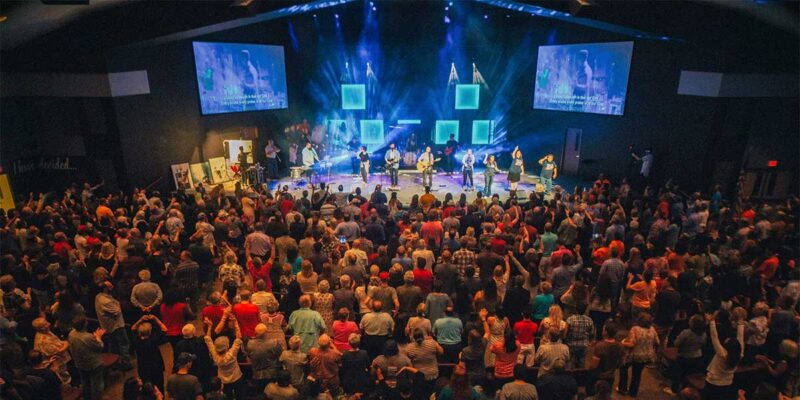Three Major Technology Shifts Coming for Churches
 In the not-too-distant future, three major technology shifts will happen in the house of worship market: wholesale lighting replacement, the micro-portable church and Video as a Service (VaaS). To be ready for these shifts, the AV industry needs to prepare for how this could play out and align their offerings to anticipate these needs.
In the not-too-distant future, three major technology shifts will happen in the house of worship market: wholesale lighting replacement, the micro-portable church and Video as a Service (VaaS). To be ready for these shifts, the AV industry needs to prepare for how this could play out and align their offerings to anticipate these needs.
As with most predictions, these future shifts are largely based on the emergence of new patterns today. This means that each of the three major technology shifts have already begun, though they may look a bit different in their current iteration than they will several years from now. As with all things, time will tell, but I feel confident that these three trends are not a flight of fancy, but inevitable for the future of local churches at least here in the United States.
Wholesale Lighting Replacement
Ten years ago, in 2007, one of the largest churches in America implemented a change from incandescent to energy-saving light bulbs that netted enough money to fund an entirely new church campus via an energy conservation program. The new campus was built with enough room for 1,000 people and the church was able to fund all of the new campus operations with the energy savings from the Plano campus, which boasts a 7,000 seat auditorium and has over one million square feet under roof.
“We have more than 100 activities here a day… seven days a week, with the heaviest use on weekends,” according to a source at the church, noting that electricity was the greatest consumer of utilities. “If we had not implemented the program, we would be paying 40 percent more.”
Of course, this mammoth campus of one of the largest giga-churches is an extreme example, but the principle of being energy-conscious has been played out in churches across the United States. In many cases, city code places higher restrictions on electrical usage per square foot, so a rising number of churches have opted to either build new campuses or retrofit older campuses to make them LEED compliant, a move that not only saves money but provides better stewardship of resources.
In the audio, video and lighting (AVL) industry the emergence of Light Emitting Diode (LED) lighting fixtures have gone from a niche segment to a full-blow industry-wide shift. The LED fixtures themselves draw a fractional amount of wattage but also are ‘cool’ technology, further reducing energy costs by eliminating the heat generated by incandescent fixtures. In what is sure to be a continued trend, expect to see wholesale changes to Compact Fluorescent Lamps (CFL) for architectural fixtures and LED for theatrical/production fixtures. Quite simply, the costs savings when amortized over decades of use simply make too much economic sense for churches to ignore the upfront costs of a wholesale change over.
The Micro-Portable Church
While I’ve written extensively about portable churches and multi-site churches here on rAVe, I’m coining the phrase “micro-portable church” to highlight a trend I see coming where the AVL technology needs of a 50 to 150 attendance venue will be more cost-effective and scalable than even today’s mid-size venues of 500 to 1,000 seats.
A long-time stalwart of the church market AVL industry is Portable Church Industries (PCI), which published an “average cost” of portable church technology systems. Here’s what they have found with their church clients:
- Approximately 40 percent of our clients (typically a new church plant) will spend an average of $76,000 on their portable church systems to launch.
- Another 40 percent (typically multi-site churches launching a moderate-sized campus) spend an average of $160,000.
- The remaining 20 percent of our clients want to launch large (new plant or new campus) and design high-tech, complex systems that exceed $750,000.
Portable church AVL tech isn’t inexpensive, as these figures show. It’s all relative, of course, to the size of the venue and location of the venue, so while these are helpful averages, they’re just that: averages, not hard-and-fast budgets. Still, I submit that the micro-portable church multi-site venues of the future will focus on even smaller venues than church plants starting from scratch. The costs may be similar or slightly lower, but the trend will be for a ‘less-is-more’ approach that will translate to lower costs. However, even if the cost is $35,000 per micro-portable venue, the concept is that there will be more of these small venues than there are of 500 to 1,000 seat venues, so the overall annual expenditure on AVL tech for micro-portable churches would be more than a smaller number or larger venues.
Shared Space Venues
Along with the trend of micro-portable church venues comes the idea that churches won’t need all of these venues seven days a week. I imagine a future where churches may purchase these smaller venues (churches already buy up space in commercial retail venues (ironically enough, named “strip mall” retail) and simply sublet them to other retail or not-for-profit organizations for weekday usage. In this way, the space is not underutilized and the church can even turn a profit on these leased-space properties that can be used to fund the weekend operations of the venue.
There are examples of churches using ‘mixed space’ venues, but this is not yet a trend and simply a projection that I think has the potential to expand into a full-blown operational model for the House of Worship market. The AVL technology that serves these spaces must be considered for how it can be used for weekday use. For example, informational kiosks can become point-of-sale kiosks and digital signage can run advertising content for the weekday tenant while the audio reinforcement system can provide in-store music and promotional advertisements. It’s also not a far-fetched idea to see the beginning of proximity marketing used first during weekday retail operations later utilized for helping first-time guests find their way to kids’ check-in.
Ultimately, as with all future prognostications, time will tell how accurate I am in considering the early adopter trends of today as having crossed the chasm to early majority adoption.
What do you think? Do you agree with Anthony Coppedge’s future church predictions for the audiovisual industry?





